-
Paper Information
- Previous Paper
- Paper Submission
-
Journal Information
- About This Journal
- Editorial Board
- Current Issue
- Archive
- Author Guidelines
- Contact Us
International Journal of Mechanics and Applications
p-ISSN: 2165-9281 e-ISSN: 2165-9303
2012; 2(5): 93-97
doi: 10.5923/j.mechanics.20120205.07
Experimental Study of the Seeding Mass Quantity Effect on the PIV Measurements Applied on a Stirred Vessel Equipped by a Rushton Turbine
Z. Driss , G. Bouzgarrou , A. Kaffel , W. Chtourou , M. S. Abid
National Engineering School of Sfax (ENIS), Laboratory of Electro-Mechanic Systems Lasem University of Sfax, B.P. 1173, km 3.5 Road Soukra, 3038, Sfax, Tunisia
Correspondence to: Z. Driss , National Engineering School of Sfax (ENIS), Laboratory of Electro-Mechanic Systems Lasem University of Sfax, B.P. 1173, km 3.5 Road Soukra, 3038, Sfax, Tunisia.
| Email: |  |
Copyright © 2012 Scientific & Academic Publishing. All Rights Reserved.
A particle image velocimetry (PIV) technique is used to study the local hydrodynamics in a mechanically stirred vessel generated by a Rushton turbine. The purpose of the present study is to quantify and to reduce errors in two dimensional particle image velocimetry (PIV). The accuracy of the velocity measurements depends on different parameters such as the seeding mass quantity, the size of the PIV measurement area, the time interval between two laser slices, and the spatial resolution. In this paper, the effect of the seeding mass quantity was analysed. More particularly, four different mass quantities of spherical polyamide particles were used and the optimum quantity is determined experimentally.
Keywords: PIV, Seeding Mass Quantity, Polyamide Particles, Hydrodynamic, Stirred Vessel, Rushton Turbine
Article Outline
1. Introduction
- A mechanically agitated tank is one of the most commonly used devices in industry for mixing. Even in simple stirred tanks but with complex geometry, the flow is often turbulent. The characteristics of turbulent flow in a stirred tank are highly complex. Using computational fluid dynamics (CFD) simulations, substantial research effort has been undertaken to link flow characteristics of mixing[1-5]. Indeed, particle image velocimetry (PIV) measurements have become in recent years an essential tool for the study of flow patterns inside agitated vessels[6]. For thus, many experimental studies on the flow pattern in cylindrical vessels have been published. For example, Baldi and Yianneskis[7] used particle image velocimetry measurements to calculate the mean velocities, Reynolds stresses and the turbulence energy dissipation rate in a stirred vessel by a Rushton turbine. Gabriele et al.[8] estimated local specific energy dissipation rates for up and down-pumping pitched blade turbines in a stirred tank using angle resolved PIV. Ranade et al.[9] used PIV results to validate numerical simulations of gas-liquid flows in a tank stirred by a Rushton turbine. Particularly, the effect of the gas flow rate on the trailing vortices behind the blades of a Rushton turbine was studied. Montante et al.[10] investigated the effect of the shaft eccentricity on the hydrodynamics of unbaffled stirred vessels. The difference between coaxial and eccentric agitation is studied using a combination of experiments carried out by particle image velocimetry and computational fluid dynamics simulations. The comparison of the experimental and simulated mean flow fields has demonstrated that calculations based on Reynolds-averaged Navier-Stokes equations are suitable for obtaining accurate results. In the turbulent flow regime, Escudié and Liné[11] used PIV to determine the mean flow field, the turbulent fluctuations and turbulencecharacteristics produced by a Rushton turbine. Aubin et al.[12] studied the hydrodynamics of the liquid phase in an aerated vessel stirred with a 6-blade pitched blade turbine using PIV measurements. A dual Rushton impeller stirred tank study was carried out by Chinmei et al.[13] using PIV measurements. Khan et al.[14] employed a PIV technique to obtain angle-resolved fields of all three velocity components close to a 45° down pumping pitched-blade turbine operated at 300 rpm in a agitated vessel. Kilander and Rasmuson[15] investigated the hydrodynamics and turbulence in a square stirred tank using a particle image velocimetry technique. The measurements were carried out for the hydrofoil impeller and the Lightnin A310. According to these anterior researches, it’s clear that the particle image velocimetry system is largely used as a recent non-intrusive experimental technique to study the hydrodynamic characteristics of the stirred vessels. However, there is a lack on the study of different experimental parameters like the seeding mass quantity, the size of the PIV measurement area, the time interval between two laser slices, and the spatial resolution. For this reason, we are interested in this paper to study the effect of the seeding mass quantity on the velocity measurements in a stirred vessel. In this investigation, four different mass quantities of spherical polyamide particles were used.
2. Experimental Apparatus
2.1. Turbine and Tank Geometry
- The present experiments were conducted in a baffled cylindrical mixing tank equipped with an inner diameter D of 300 mm (Figure 1). The tank was filled with water to a depth H equal to D. The cylindrical tank was placed in a square plexiglass tank of larger dimension and the space between the two tanks was filled with water. This was done to greatly reduce refraction from the outer curved surface of the cylindrical tank. The used tank was equipped with four baffles, of width b=D/10, made from 3 mm thick plexiglas. The standard design Rushton turbine, with a diameter d=D/3, was installed in the stirred tank within a shaft of diameter s=10 mm. The clearance y, measured between the bottom of the mixing vessel and the impeller-disk plane, was equal to the impeller diameter (y=d). The blade height was equal to h=0.2 d. The impeller rotation is equal to 130 rpm.
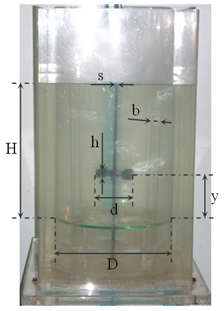 | Figure 1. Stirred tanks configurations |
2.2. PIV System
- The PIV system used was the commercial system acquired from Intelligent Laser Applications (Figure 2). The laser sheet source adopted was a pulsed Nd:YAG laser, emitting light at 532 nm with a maximum frequency of 15 Hz. The double-image capturing was performed by a PCO Camera with a 1600×1200 pixel Charge Coupled Device (CCD). The time between laser pulses was ∆t=1 ms. The laser control, the laser/camera synchronisation, the data acquisition and the processing were handled by a hardware module "PIVSynch" and FlowManager software "VidPIV 4.6" installed on a computer. A digital encoder was mounted on the shaft of the Rushton turbine. The laser and the camera was synchronized with the encoder signal in such a way that measurements can be carried out at a specified angle from the impeller blade. The liquid was seeded with spherical polyamide particles of mean diameter equal to 20 µm. In PIV measurement, the motion of particles in the section illuminated by the laser sheet was recorded with a digital camera. Two subsequent flow images with about 1 ms time delay are used to calculate the instantaneous two-dimensional velocity field (axial velocity and radial velocity). Each of these images was divided into small interrogation area (IA). Each IA in the first image was then correlated with the corresponding IA in the subsequent image. VidPIV4.6 software was used to interrogate the images with two frames Fast Fourier Transform (FFT) cross-correlation with 50% overlap between interrogation windows. Interrogation size can be 128×128 pixels2, 64×64 pixels2 or 32×32 pixels2. The smaller interrogation window can provide higher spatial resolution, but it also comes with higher errors in the analysis result due to the lack of particles within the smaller interrogation area. Therefore, 64×64 pixels2 interrogation size was used in this work.
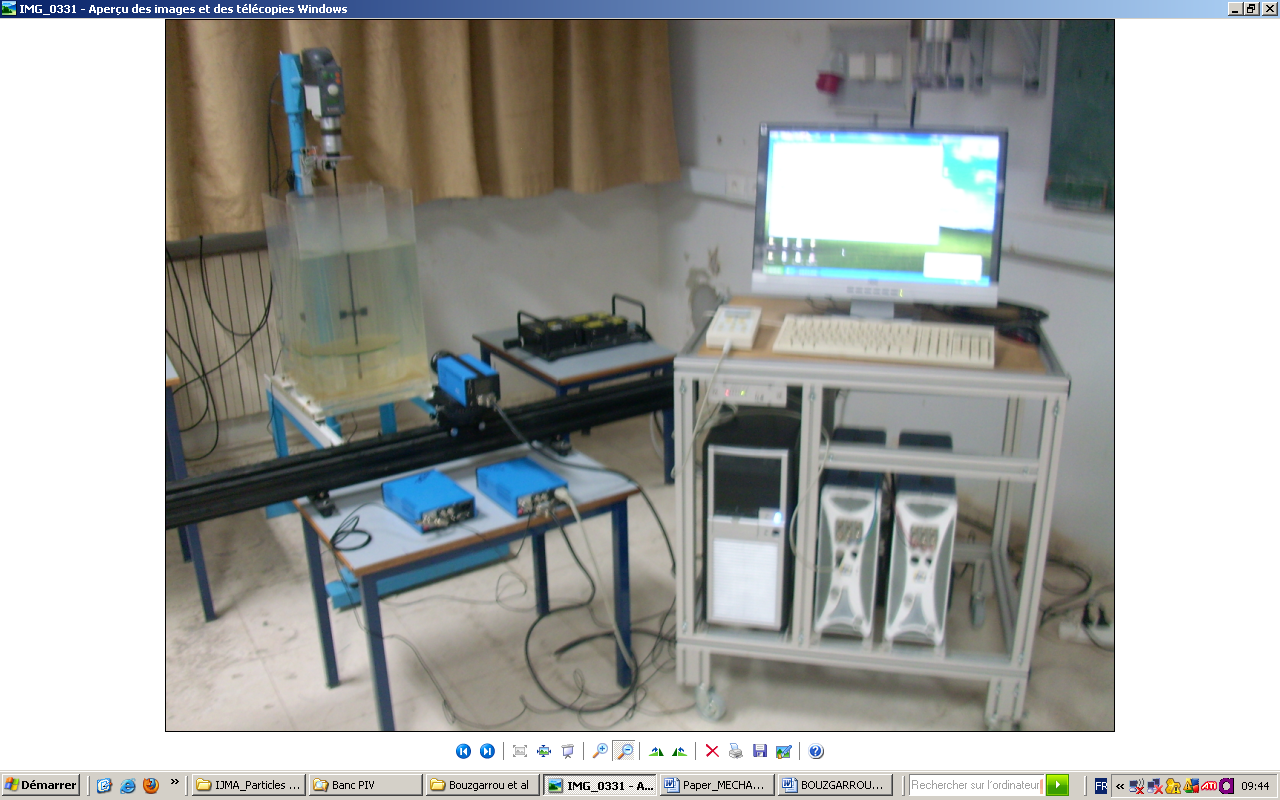 | Figure 2. PIV apparatus installed on the agitated vessel |
2.2. PIV parameters
- The purpose of the present study is to quantify the adequate mass quantity of spherical polyamide particles in order to reduce errors in two-dimensional particle image velocimetry (PIV). The accuracy of the velocity measurements depends on different parameters such as the seeding mass quantity, the size of the PIV measurement area, the time interval between two laser slices and the spatial resolution. In this paper, the effect of the seeding mass quantity was studied. More particularly, four different mass quantities of spherical polyamide particles were used as described in table 1. These mass quantities have been obtained through the precise measurement of four typical weights.
|
3. Experimental Results
3.1. Data Acquisition
- Figure 3 shows the recorded images for the fourth cases characterised by four mass quantities of spherical polyamide particles. In our study, 170 couples of images were recorded for every acquisition. The image analysis allows the determination of the velocity vector in a defined area that contains a large number of particles.
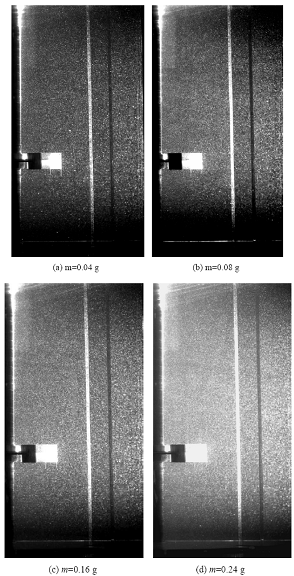 | Figure 3. Data acquisition |
3.2. Mean Velocity Fields
- Several criteria concerning the post processing of the results have been optimized to obtain good resolution of the instantaneous and average flow fields (Figure 4). All the vectors which have one of their velocity components higher than the agitator tip speed were considered out of the allowable range and were deleted from the figure 4.
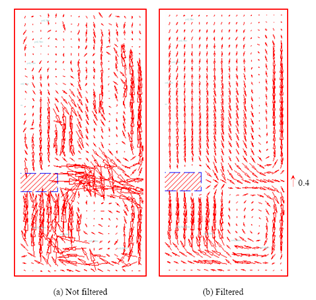 | Figure 4. Elimination of processing errors using correlation error correction |
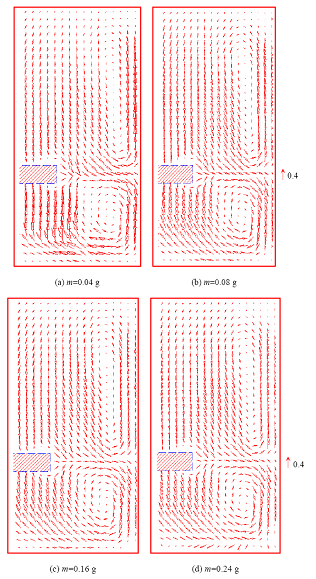 | Figure 5. Velocity fields induced in r-z plane defined by the angular coordinate θ=35° |
3.3. Comparison of the Velocity Profiles
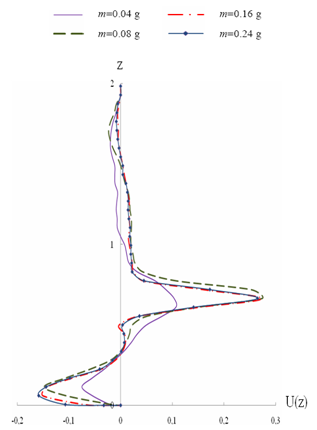 | Figure 6. Dependence of axial profiles of the radial velocity component on seeding mass quantities |
3.4. Interrogation Strategy
- The mass quantities of the spherical polyamide particles have two effects in the evaluation of PIV images. In fact, the probability of valid displacement detection increases when more particle image pairs enter in the correlation calculation. Also, the number of image pairs captured in an interrogation area depends on the overall particle image density, the amount of in-plane displacement and the amount of out-of-plane displacement. Indeed, the mass quantities of the spherical polyamide particles affect the technique used to interrogate images. In fact, at low image it is achieved by simply matching nearest neighboring individual particle image pairs. This technique is known as particle tracking technique (PTV). At high image, it becomes inefficient (figure 7). Hence another approach should be employed, which is a statistical approach capable of identifying the most probable match of particle images in the two frames.
 | Figure 7. Interrogation images techniques |
4. Conclusions
- In this paper, the effect of the seeding mass quantity was studied. This parameter is one of the most important operational parameters and is one of the most common factors responsible for erroneous vectors. According to these experimental results, it has been noted that the seeding mass quantities has a direct effect on the hydrodynamics results of the stirred tank. For thus, it’s reasonable to use just the necessary of the spherical polyamide particles mass quantities in the stirred tank. An excessive quantity can introduce other problems due to the excessive reflections of these particles.In the future, we propose to characterize the effect of the size of the PIV measurement area, the time interval between two laser slices and the spatial resolution on the velocity measurements in a stirred vessel. Other geometrical configurations can also studied to characterise the hydrodynamic structure in the stirred tanks.
NOMENCLATURE
- b: width of the baffles (m)D: diameter of the cylindrical tank (m)d: diameter of the impeller (m)h: blade height (m)H: water depth (m)m: mass (kg)r: radial coordinate (dimensionless)R: radius of the tank (m)s: shaft diameter (m)t: times (s)U: radial velocity component (dimensionless)V: tangential velocity component (dimensionless)W: axial velocity component (dimensionless)y: clearance of the turbine in the tank (m)z: axial coordinate (dimensionless)
 Abstract
Abstract Reference
Reference Full-Text PDF
Full-Text PDF Full-Text HTML
Full-Text HTML